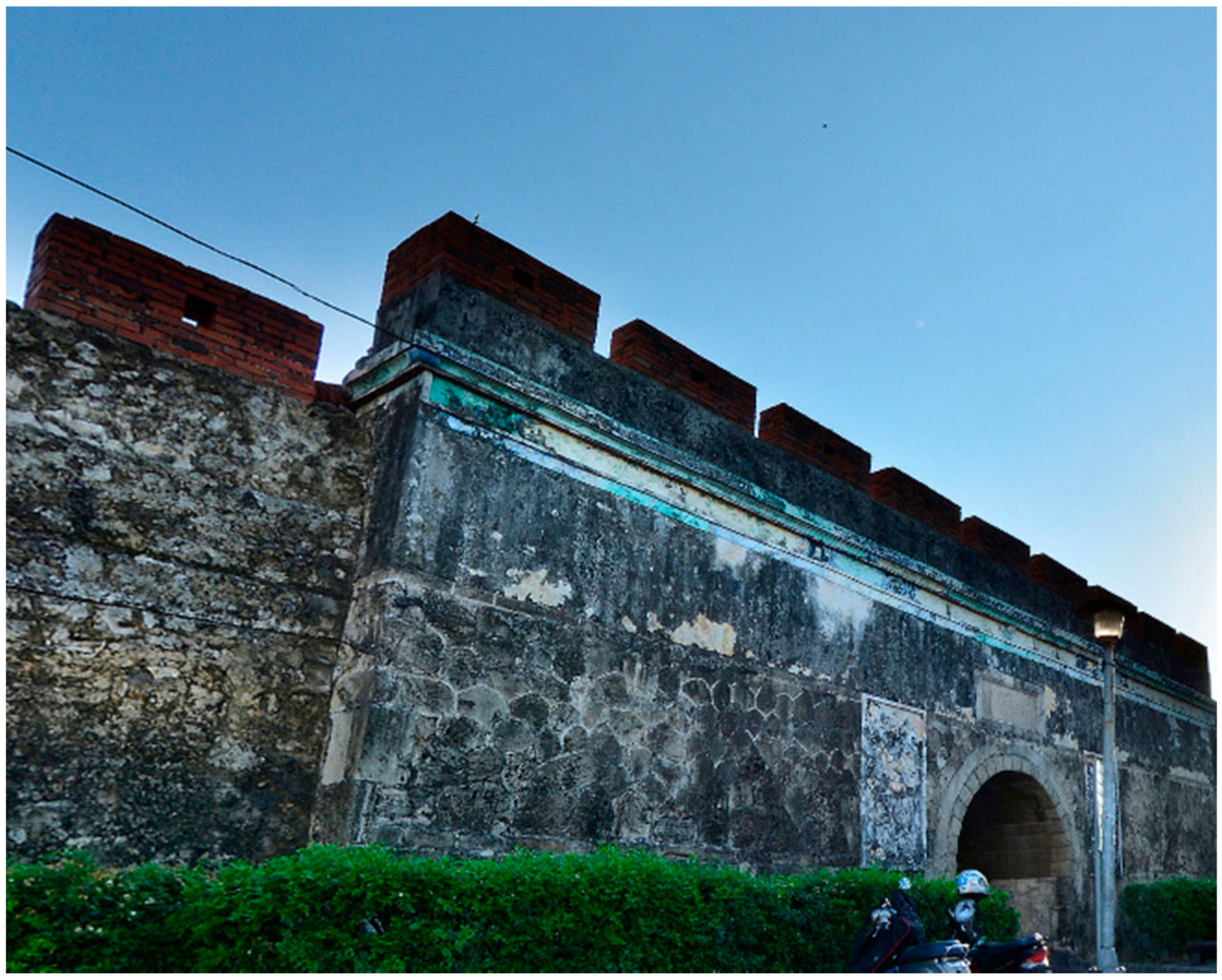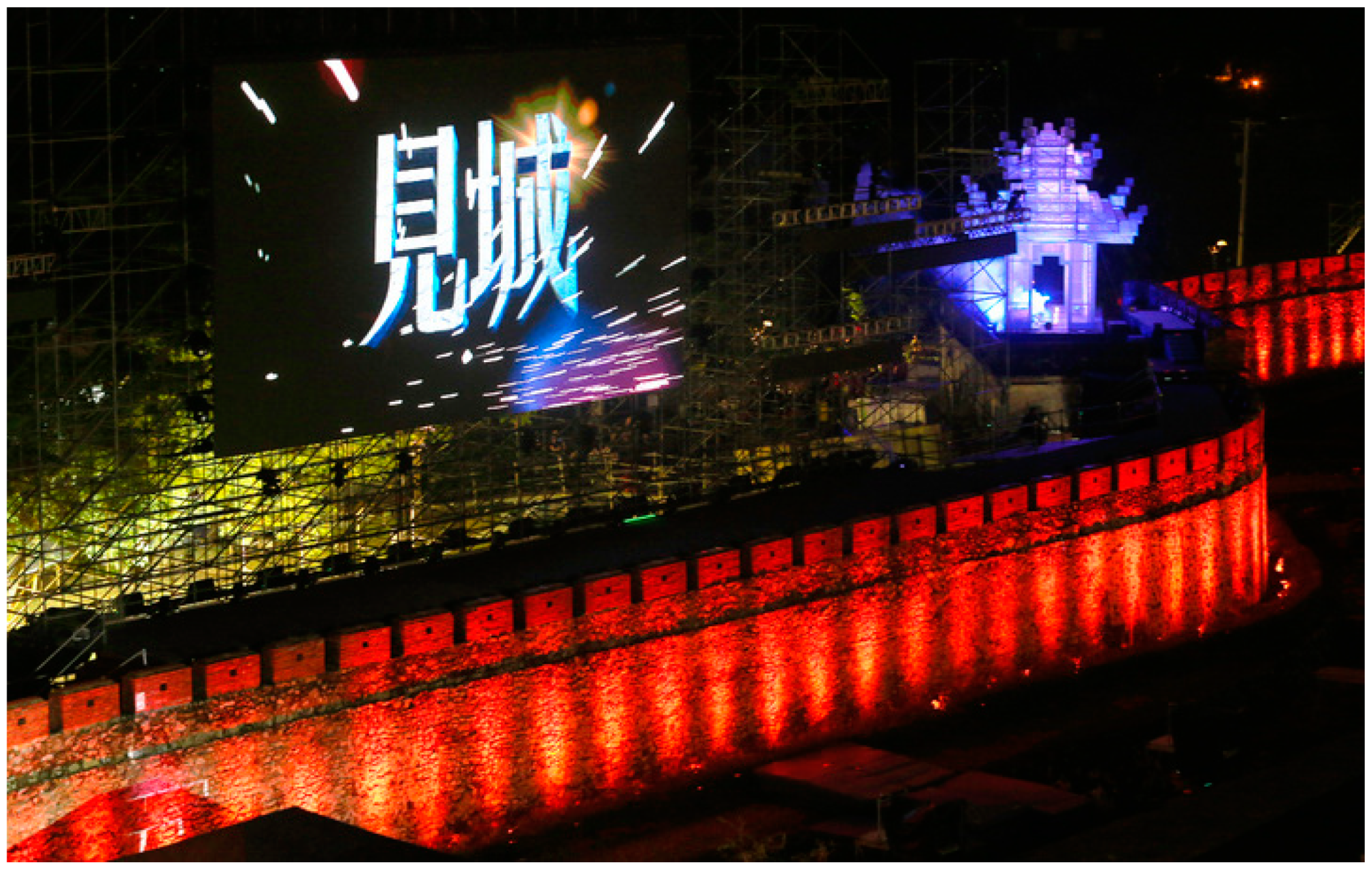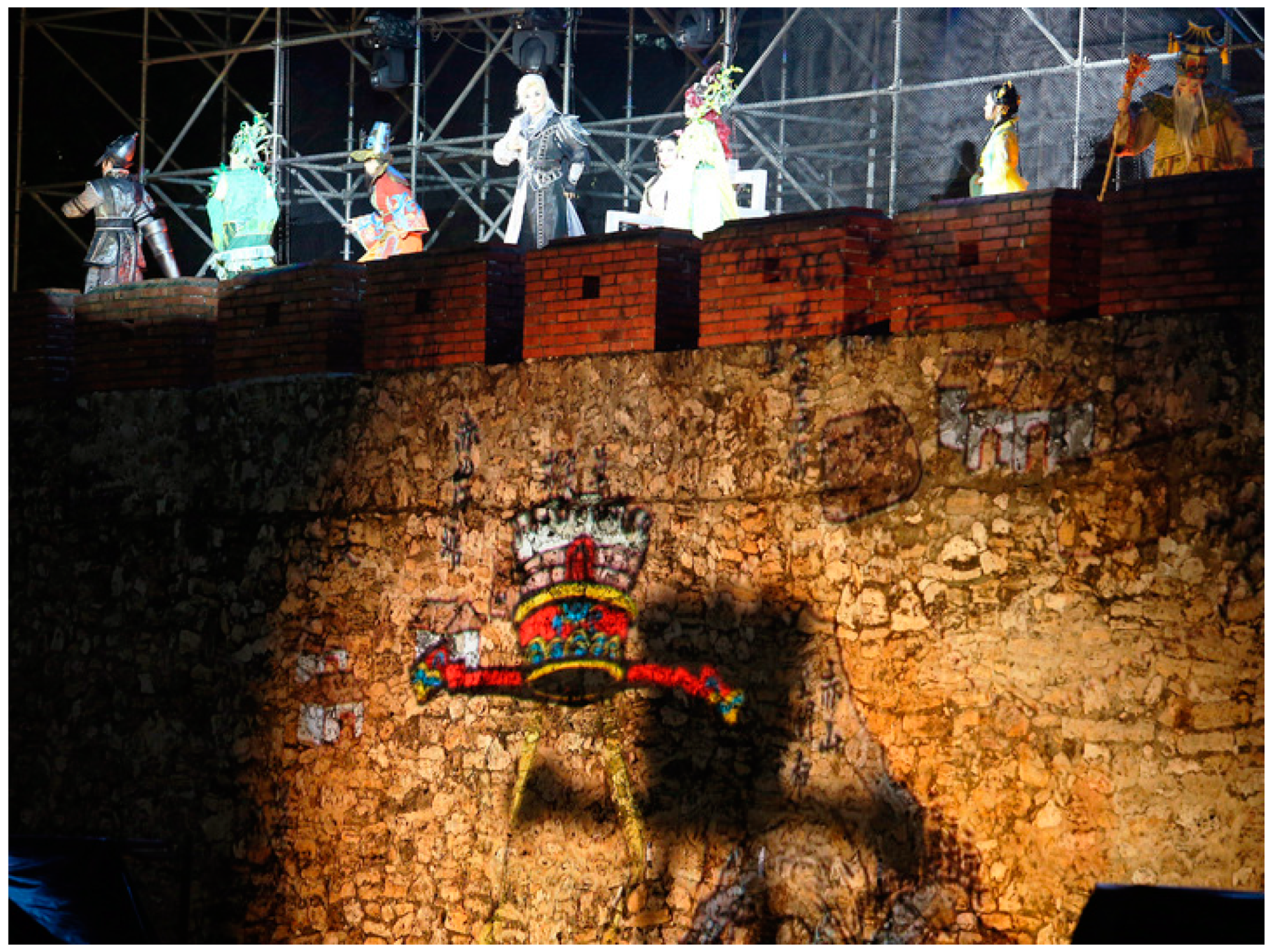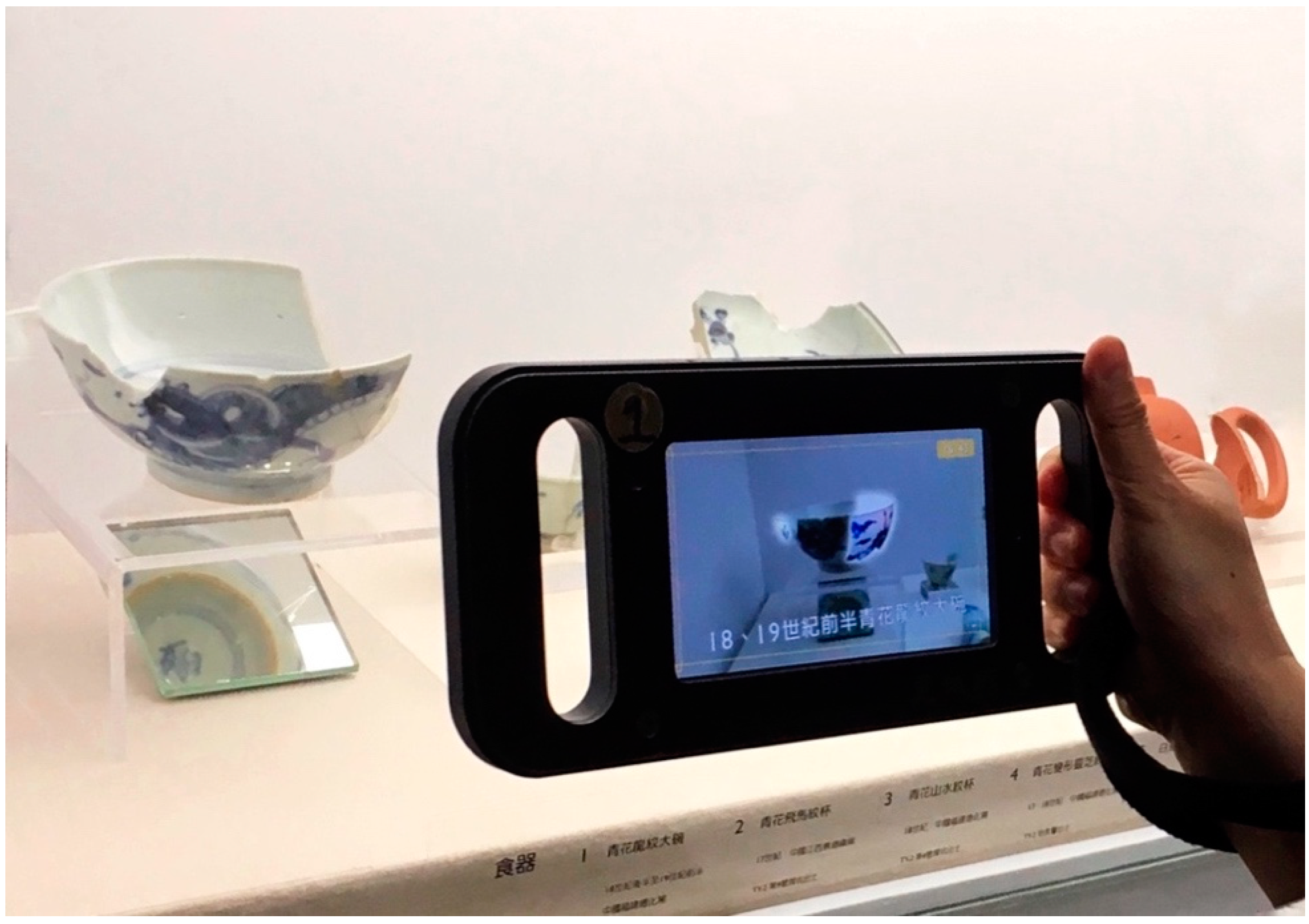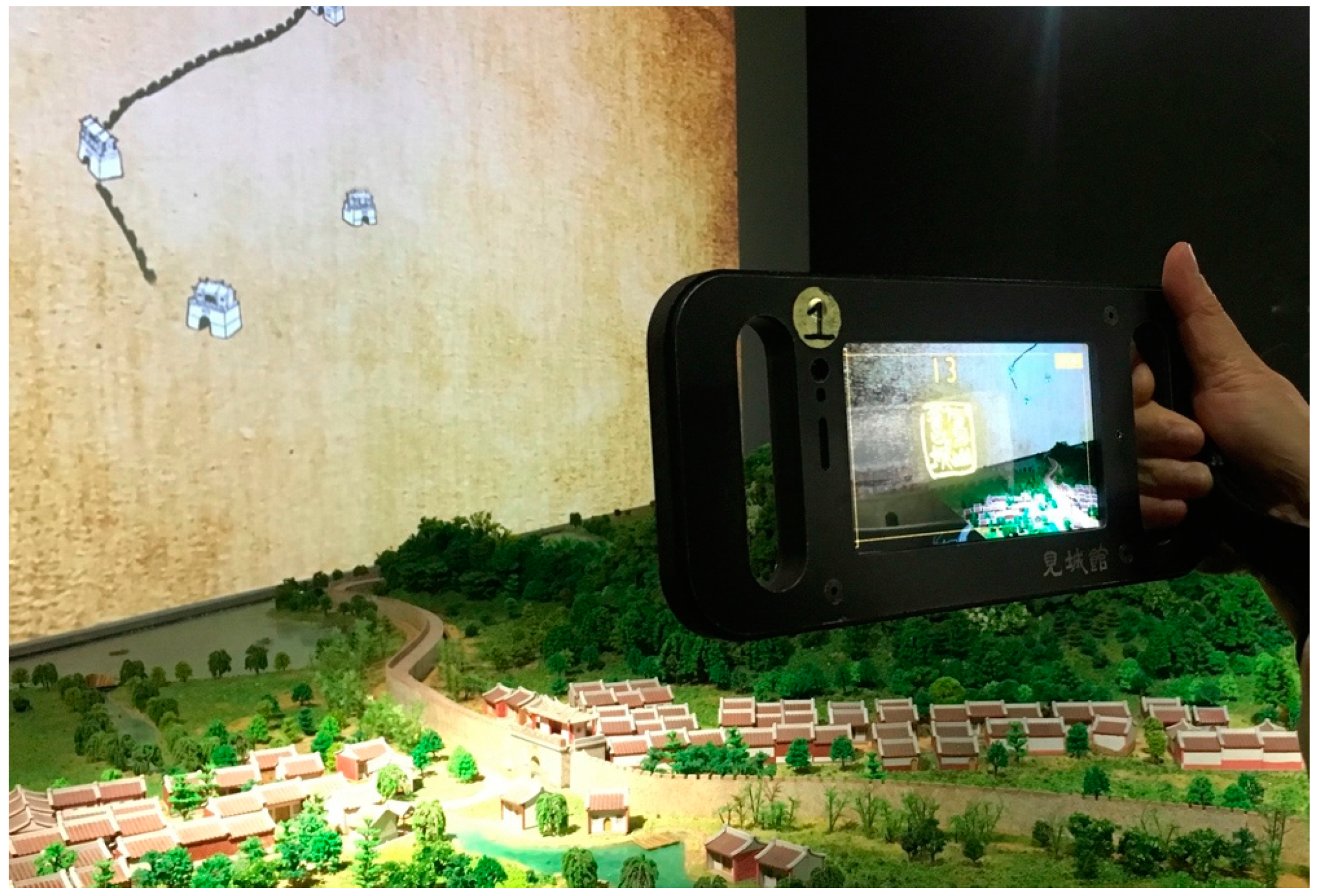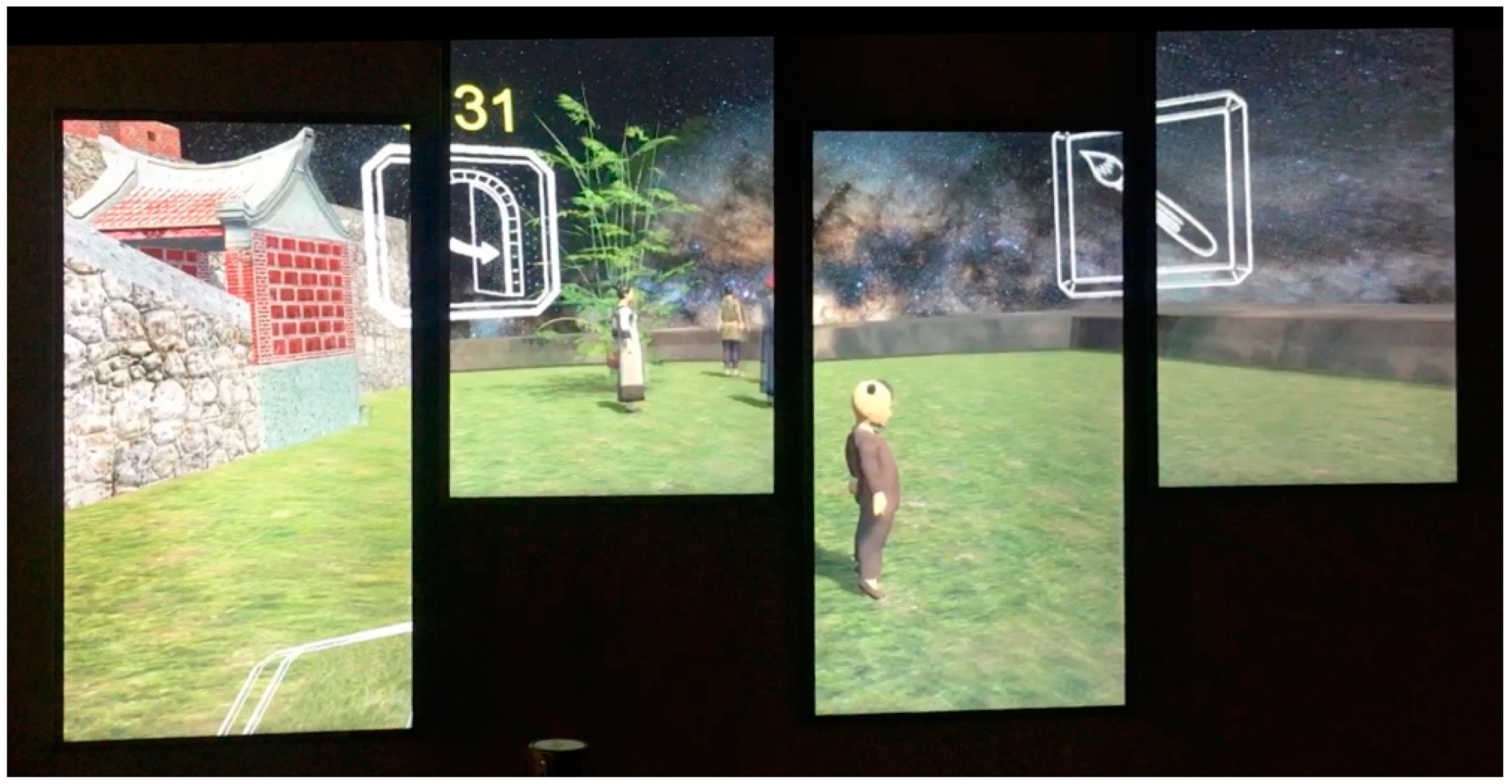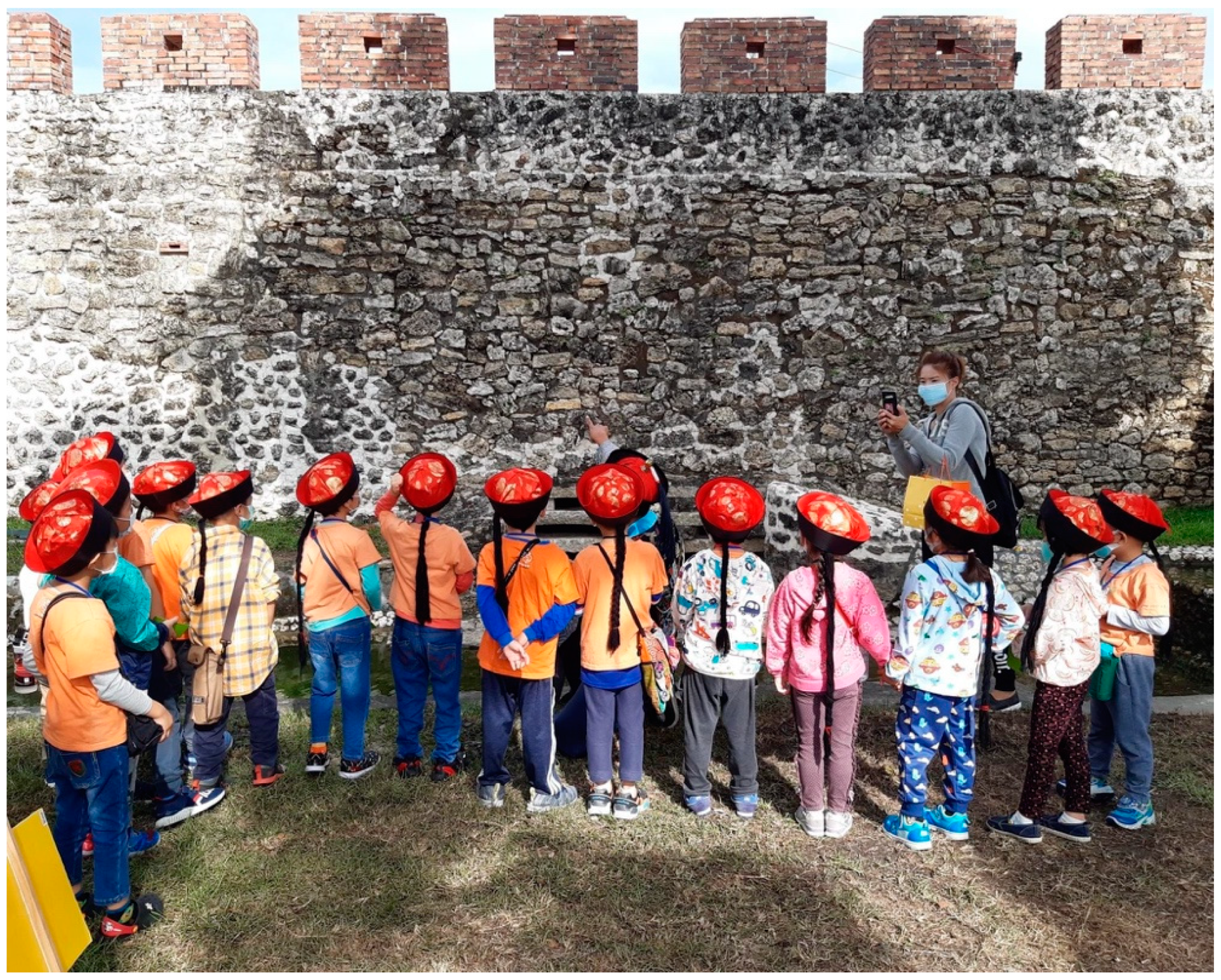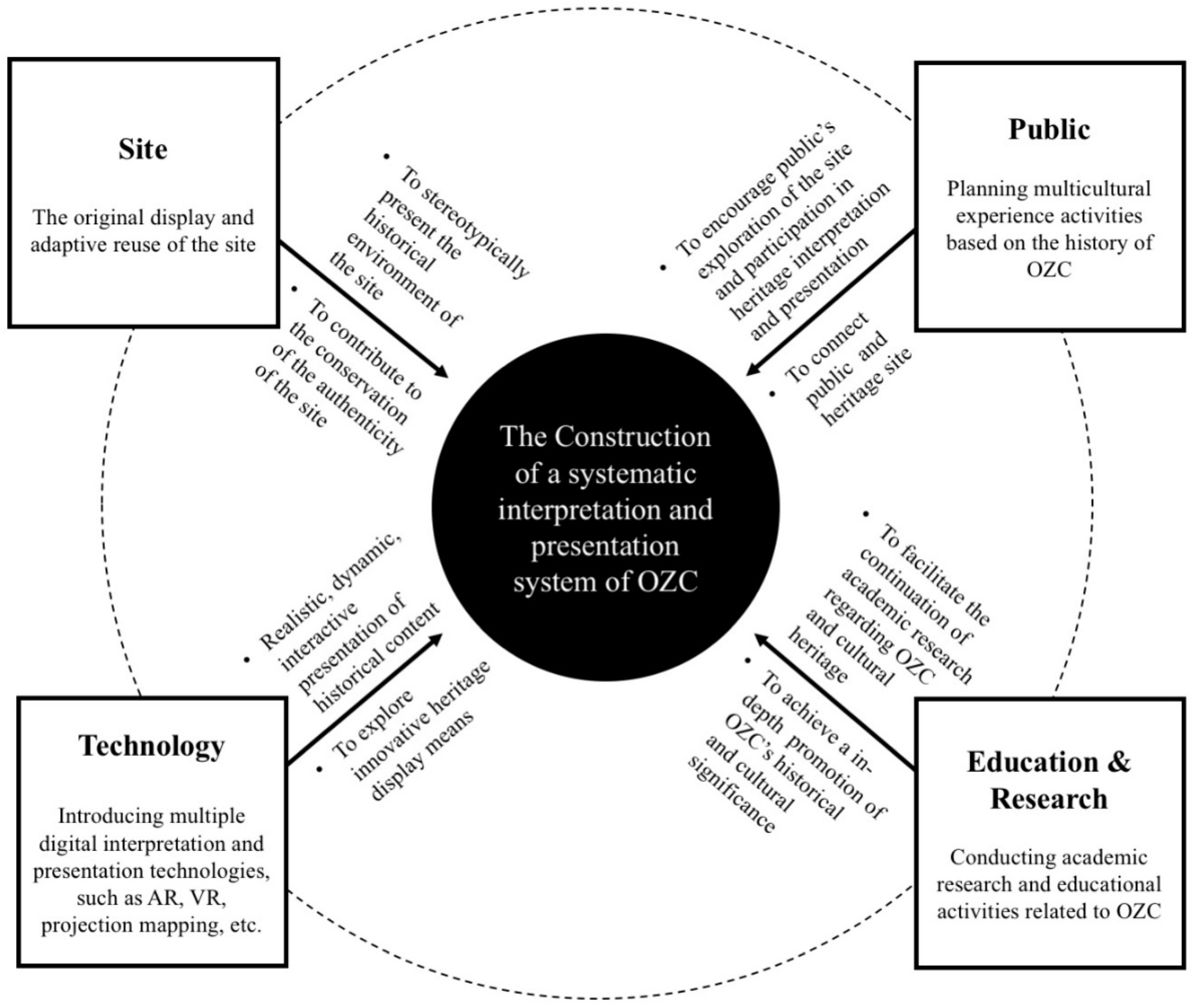1. Introduction
As an essential component in the whole heritage conservation process [
1,
2,
3], interpretation and presentation of heritage sites undertake missions of communicating cultural identities and cultural values, enhancing visitors’ understanding and enjoyment of and positive attitude toward the heritage site [
4] and encouraging “the high level of public awareness and support necessary for the long-term survival of the cultural heritage” [
3]. For the past few years, the continuous development of the heritage display concept, the gradual rise of globalized heritage tourism, and the advances in digital technologies and media communications have resulted in new possibilities, requirements, and complexities in the overall planning, purpose, technical means, and methods of interpretation and presentation of cultural heritage sites [
2,
5,
6]. In response to these new opportunities and challenges, it becomes a significant mission, as well as a challenging task for cultural heritage institutions, to plan and construct a systematic interpretation and presentation program of cultural heritage sites that can effectively communicate heritage information and value to the public and provide visitors with positive and valuable experience.
Since the implementation of the Cultural Heritage Preservation Act [
7] in Taiwan in the 1980s, the relevant norms regarding the definition, classification, categories, application, and protection of cultural heritage have been defined, and it is also explicitly stated that managing agencies (institutions) and public or private legal entities of cultural heritage sites shall “strengthen mutual, equal cooperation in conducting commemorative enterprises such as preservation, education, and exhibitions of related histories, events, and characters on or in such public spaces or buildings”. The interpretation of cultural heritage began to be taken seriously. Following this, a series of related policies launched by the Ministry of Culture of Taiwan, such as the Implementation Rules of the Cultural Heritage Preservation Act [
8], the Rules for the Management and Maintenance of Monuments [
9], the Rules for the Restoration and Reuse of Monuments [
10], and the Cultural and Scientific Policy Framework [
11], have provided further specific recommendations and guidelines on different aspects (protection and revitalization measures, education and promotion activities, use of technological media, etc.) of interpretative and presentative activities of cultural heritage.
Moreover, to address the challenge of lack of comprehensive management plans for Taiwan’s cultural heritage, especially for “architectural cultural heritage sites” (monuments, historic buildings, and commemorative building), the Taiwan Ministry of Culture launched a public infrastructure investment project, the Regeneration of Historic Sites Project (RHSP) in 2016, aiming to reproduce the historical meaning of each site and to guide people through diverse historical memories, connecting the current generation with cultural values through the utilization of diverse interpretation and presentation strategies [
12]. With the support of the project, two phases of 24 cultural heritage sites around Taiwan are beginning a new evolution of their interpretation and presentation systems. As one of the exemplary projects, the Renovation Project of Zuoying Old City (OZC), Kaohsiung, was approved by the Taiwan Ministry of Culture in June 2016, and the first phase of the interpretation and exhibition system was completed and opened to the public in 2018. The project is also considered an unprecedented large-scale cultural heritage preservation plan that demonstrates the evolution of the cultural heritage preservation and interpretation concept in Taiwan [
13], which makes it a suitable setting for understanding and evaluating the current development of interpretation and presentation strategies and practical applications in cultural heritage sites of Taiwan.
This current paper seeks to take a holistic perspective to analyze the interpretation and presentation system of OZC in depth through participative site investigation and in-depth interviews, thereby providing a reference for the construction, implementation, and management of interpretation and presentation system at cultural heritage sites.
2. Interpretation and Presentation of Cultural Heritage Sites
The discussion of presentation in international heritage conservation documents can be traced back to the Convention Concerning the Protection of the World Cultural and Natural Heritage [
1], in which UNESCO divided the process of heritage conservation into four distinct phases and identified the presentation of cultural heritage as an integral part of it. Since the early 20th century, modern cultural heritage conservation has gradually formed a mature theoretical system, and the concept of heritage interpretation and presentation has been extended and developed, from emphasizing the protection and restoration of the material entities of heritage, to comprehensively displaying the historical and cultural connotations of heritage to the public, so as to realize the social and cultural values of heritage [
4,
14,
15].
Since heritage interpretation and presentation should be conducted on the basic premise of not damaging the authenticity and integrity of the fabric of a cultural heritage site, and with the important objective of achieving continuous research and promotion of the historical and cultural values of the heritage [
2,
14], the planning of the display use of the remains and spaces of the site, and the promotion and encouragement of continuous and effective heritage related education and academic research, have been identified as two most fundamental orientations to be considered in the processes of designing a heritage interpretation and presentation system [
2,
16,
17]. In addition, the introduction of elaborate interpretive technologies and the transformation of the promotion and management strategies of cultural heritage sites driven by the rise of cultural tourism have brought new complexities to the interpretation and presentation of cultural heritage sites at this stage [
5,
6] and have resulted in increasing focus on the appropriate use of new technologies, especially digital technologies, in interpretive design, as well as on better planning and providing a positive and valuable experience for visitors at heritage sites [
3,
4]. Therefore, this study would discuss on-site interpretative and presentative planning, settings, and activities, with an emphasis on four aspects: the use of the site, the application of interpretative and presentative technologies, public participation, as well as further education and research of the site to explore the current development of interpretation and presentation of cultural heritage sites in Taiwan in the light of new opportunities and challenges.
One of the key issues to be considered in heritage interpretation and presentation is the planning of the presentation of the site spaces and the architectural structures themselves. The Burra Charter [
17] pointed out that it is important to identify appropriate ways in which the significance of the site can be understood and the “use of the place” is crucial in the interpretation process. On the other hand, the Venice Charter [
18] and the Nara Document on Authenticity [
19] proposed a series of guidelines for the conservation and presentation of cultural heritage sites from the perspective of heritage authenticity. Besides, the 2008 ICOMOS Charter also explicitly emphasizes that interpretation and presentation should support the conservation of the authenticity of the heritage site and avoid “irreversibly altering its fabric” [
2].
In both the 1972 UNESCO Convention and the 1999 ICOMOS Charter, it is stated that the heritage conservation process, including presentation work, should “take advantage of scientific and technical advances” and use appropriate technical forms [
1,
3]. In recent years, digital technology, with its unique attributes of interactivity, immersion, and realism, has been increasingly used at cultural heritage sites and enriched the means of interpretation and presentation [
5], with many typical applications emerging, such as the augmented reality (AR) tour system for the Archaeological Site of Olympia, the virtual reality (VR) mobile application, VR Scope for Japan’s World Heritage Site, Himeji Castle.
Apart from their historical and cultural value, heritage sites are more valuable for their interaction with people and their memories [
20]. The conservation, presentation, and interpretation of cultural heritage sites should therefore not only focus on the preservation of static shells or the promotion of one-sided historical information, but also the revitalization of their intrinsic historical value and their connection to public life. It is also highlighted in the 2008 ICOMOS Charter that interpretation and presentation should be “physically accessible to the public” to “assist them in establishing a meaningful connection” to heritage sites [
2].
The presentation and interpretation of a heritage site is a dynamic activity that is constantly being updated as the scholarly study of the site becomes more advanced and extensive [
15]. Ongoing research is an essential part of the interpretation of cultural heritage sites, and every interpretation project should be considered as “an educational resource for people of all ages” and to “stimulate further interest, learning, experience, and exploration” [
2].
Accordingly, primary research in the form of field investigation and participant observation was carried out to evaluate the implementation details of an on-site interpretation and presentation system of the selected venue from these four main aspects. Specific findings are now discussed in the following section.
3. The Construction of OZC’s Interpretation and Presentation System
3.1. History of the Old City, Zuoying, and the Renovation Project
As one of Taiwan’s first stone fortifications, Old Zuoying City (OZC) is a well-known cultural heritage site situated in Kaohsiung, Taiwan. Built-in the Qing Dynasty, OZC, which is currently the largest and most well-preserved ancient city in Taiwan, has witnessed the historical and cultural changes of Taiwan in different periods, including the Ming-Qing Dynasty, the Dutch period, and the Japanese occupation period, owning a special position among other ancient cities built during the same period. For its significant historical, cultural, and architectural value, OZC was registered as a first-level monument by the Taiwan Ministry of the Interior in 1985. In 2011, the remains of the West Gate city wall were also added to the old city’s site boundaries, making OZC an important cultural heritage site with complete city structure and ancillary buildings (e.g., moat and clay sculptures of door gods, etc.).
As mentioned earlier, in the year 2016, OZC was selected as a significant implementation site in the Regeneration of Historic Sites Project (RHSP) launched by the Taiwan Bureau of Cultural Heritage to support the revitalization of local cultural heritage and resources. Guided by the project vision of RHSP of presenting the past to the public by applying innovative experiential methods [
12], the Bureau of Cultural Affairs of Kaohsiung City Government further proposed a mid-long-term project for the redevelopment of OZC, the OZC Renovation Project (2016–2024), and defined the project target as “reappearing historical scenes of the first Taiwanese stone fortification” [
21].
In addition to the preservation and restoration of the old city ruins and related artifacts, the core concept of “reappearing” also emphasizes the construction of a comprehensive and systematic heritage interpretation and presentation system through the integration of different display forms and the introduction of the latest digital display technologies to present OZC’s history to visitors, evoke the public’s memory of the historical site, and promote the public’s recognition of the value of cultural heritage [
13,
21].
Currently, the first phase of the project (including the design and implementation of the on-site display, the construction of the digital heritage museum, planning and organization of visitor experiential activities and guided tours, etc.) was completed and opened to the public in 2017. Accordingly, the investigation and evaluation of the construction of historical and cultural interpretation and presentation system in OZC would help to develop an understanding of the evolution of the concept regarding the cultural heritage site conservation in Taiwan today.
3.2. Analysis of the Interpretation and Presentation System of OZC
Although the OZC was registered as a first-level monument as early as 1985, no systematic display program had been established at the site, and only a portion of the old city, such as the East Gate and the remains of its city wall, was open for public visitation. With policy support and funding from the RHSP in 2016, the Bureau of Cultural Affairs Kaohsiung City Government, which is the organizer of the OZC Renovation Project, has developed a new interpretation and presentation framework to provide guidance on the planning and implementation of specific tasks related to the redevelopment of OZC. This framework indicates that the main objective of the OZC interpretation and presentation work is to achieve the promotion of cultural heritage values and repositioning of cultural heritage preservation through the effective integration of cultural presentation with historical narratives, and community and social participation [
13]. Guided and facilitated by this framework, the construction of a series of interpretation and presentation projects for OZC has begun.
To explore and investigate the details of the interpretation and presentation system of OZC and gain a further understanding of the vision and concept of the interpretation and presentation planning, a qualitative approach, including site investigation, participant observation, and interview, was adopted in this study. The research was conducted over a half-year period, from March 2019 to August 2019. Two main phases were undertaken. Based on the review of relevant literature regarding heritage display and history of OZC, the first phase of the fieldwork evaluated details of the interpretation and presentation system of OZC in terms of display contents, display forms, technical means, related cultural activities by using general field observation and participant observation. Observation results were recorded in the form of photos, videos, and text descriptions. As a supplement to the findings of the first phase of the study, the second phase, mainly through semi-structured interviews with the staff and manager of OZC, progressed towards a further understanding of the objectives and conceptions for the details of the interpretation and presentation system.
Based on the four directions proposed in the previous section, findings on the current construction of interpretation and presentation system in OZC would be analyzed and illustrated with concrete display examples in the following sections.
3.2.1. The Stereotypical Presentation of the Historical Environment: The Original Display and Adaptive Reuse of the Site
Since the period of Japanese occupation, OZC has been extensively damaged due to street development and the construction of a military port [
22]. At present, only the East Gate, the South Gate, and the North Gate, as well as some of the remains of the city wall, are relatively well preserved [
23]. The interpretative and presentative concept of the OZC Renovation Project does not advocate reconstruction of the destroyed pattern of the old town, but rather a direct presentation of the existing preserved structures based on necessary restoration. For instance, the North Gate of the OZC (
Figure 1) is still structurally intact, but the building on top of the gate collapsed as early as the Japanese occupation period. The OZC Renovation Project does not rebuild the gate, but rather cleans, strengthens, and restores the gate and city wall construction, and interprets the history and the original architecture of the buildings through a combination of the direct display of the existing preserved structure and descriptions on the information panel (
Figure 2). This approach of “direct displaying heritage buildings that are in relatively good condition and resistant to environmental damage” [
15] is adopted by many cultural heritage sites, such as the Old Summer Palace of China and the Hadrian’s Wall of United Kingdom.
Likewise, the inner-city space of OZC is interpreted in a similar manner. Due to the significant changes that have taken place in the last hundred years, there are no remains of the original Qing dynasty government offices, temples, or residential buildings in the inner-city space of OZC. However, archaeological excavations have revealed the remains of prehistoric, Qing dynasty, and Japanese occupation from various historical periods under the surrounding area of the West Gate [
25]. The OZC Renovation Project has preserved the archaeological site in its original condition and opened it to the public after necessary conservation and treatment. The project also proposes a concept of “trial excavation as exhibition” [
26] and, in collaboration with archaeologists, launches a series of participatory archaeological activities to encourage public to participate in OZC’s historical exploration and to “step out of the written history and enter the landscape, space, memory, and archaeological remains of OZC” (
Figure 3) [
21]. Depending on the archaeological stratigraphy and participants’ own experience and knowledge, they will be guided and involved in different archaeological excavations that are appropriate to them, such as participating in the excavation of certain layers, trying to assist in the operation of records or equipment, sifting through soil or cleaning specimens, or volunteering at archaeological events [
27]. In the process, the public can contribute their life experiences and knowledge to form part of the OZC archaeological research; at the same time, participants can also construct their own experiences and memories of OZC, accumulate the experience of the archaeological excavation, and complement or integrate their own understanding of OZC as a foundation for the continuous promotion of the preservation of the heritage. As one of the main leaders of the archaeological research of the OZC Renovation Project and a leading proponent of public archaeology activities, Prof. Zhong from the Institute of Archaeology, National Cheng Kung University, pointed out that the purpose of the public archaeology project is to collaborate with the local community to conduct historical archaeology research, in addition to purely academic studies, to further explore how the research process and research results can be integrated with the cultural heritage, with the ultimate goal of integrating the lives of residents with the sustainable development of OZC [
28]. This approach also echoes the concept of “public archaeology” [
4], with related activities occurring at many European and American cultural heritage sites.
In addition, the OZC Renovation Project also attempts to explore the possibility of adaptive reuse of the heritage space, a representative example of which is the environmental theater renovation of the East Gate and its city wall remains in 2018. Based on Richard Schechner’s theory of “environmental theater” [
29], the design team led by Suming Zen transformed the historical space without destroying its original appearance, using lighting, digital projection, and various art installations to create new meanings for the site [
30] (
Figure 4). In March of the same year, a historical drama, “Seeing the Old City”, which was created based on the history of OZC, was performed in the historic-site theatre transformed from the East Gate of OZC (
Figure 5), interpreting the history of the old city to the public and promoting the value of the heritage site through this largest outdoor environmental theater in Taiwan.
3.2.2. Exploring Innovative Display of Heritage: The Construction of Digital On-Site Heritage Museum
In response to the changes and developments in digital technology that have opened up new possibilities for the interpretation and presentation of heritage, one of the key missions of the RHSP to reproduce the historical meaning of different sites through the utilization of diverse media, especially the application of emerging digital technologies [
7]. Furthermore, in the particular case of OZC, as most of the original buildings and spaces within the old city have been extensively damaged, the use of digital technology to recreate the original appearance of the OZC and its evolutionary history is an important complement to the original display of the remains of the site. Therefore, the OZC Renovation Project, as a sub-project of RHSP, integrated digital technology as an important display means into the entire interpretation and presentation system and constructed a digital on-site museum, the Center of Old Fongshan City History (COFCH)
1.
Located near the East Gate of OZC, COFCH is the focus of the first phase of The OZC Renovation Project, which was completed and officially opened to the public in 2017. Unlike conventional museums that focus on static displays, COFCH is a new kind of museum that emphasizes visitor’s participation and interaction through the use of digital technology, with the interpretation goal of “displaying the lost history of the old city through dynamic models, augmented reality (AR), virtual reality (VR), and other interactive designs and exchanging historical memories with cultural experiences” [
13]. There are eight exhibition areas in the museum, and the interpretation covers the historical evolution of OZC (construction history, important historical events, anecdotes and legends, etc.), the architectural structure of the site (architectural layout, city structure, functional explanation, etc.), and the results of the archaeological investigation of OZC (excavated cultural relics and documents and historical materials related to the old city, etc.).
As a digital museum, COFCH explores the innovative use of digital technology in heritage interpretation and presentation in two main directions.
Firstly, it integrates various digital technologies (digital motion graphics, projection mapping, AR, etc.) to dynamically and realistically reproduce abstract historical contents, damaged or non-existent buildings, and cultural relics. On the first floor of the COFCH exhibition area, for example, a “theater-style” moving model that restores the architectural structure of OZC from different periods is on display. During the 8-min moving model show, 50 sets of vertical movement components in the model, together with a digital animation video describing the historical and cultural evolution of OZC across time and projection mapping to create light and shadow effects, are performed at specific points in time (
Figure 6). The changes in the construction of buildings within OZC at different periods are explained dynamically, helping visitors to interpret the overall pattern of the site and to establish a clear understanding of the development of the historical context. Another exhibition area on the first floor, Treasure Hunt in the Old City, similarly combines AR technology with 3D animation technology to perform virtual restoration of damaged archaeological artifacts and to provide additional historical information (
Figure 7).
Secondly, due to the uniquely interactive nature of digital technology, public co-creation is appropriately incorporated into the displays, encouraging the public to participate in the exploration and interpretation of cultural heritage. For instance, the Treasure Hunt in the Old City section introduced above uses the theme of “treasure hunting” to link up the entire exhibition, encouraging visitors to search for digital content within the display area. A total of 15 AR digital content display trigger points has been constructed, each of which corresponds to an important artifact or a historical event. Visitors can explore the area freely with the AR devices provided by the museum and locate the trigger points with virtual coins to get a further historical and cultural introduction of the corresponding exhibited objects (
Figure 8). Similarly, in the VR gaming experience area, Our Old City, on the second floor of COFCH, visitors can enter the virtual world of the old city with the VR devices provided in the museum and choose different angles to interpret the 3D recreated OZC; more importantly, visitors are also encouraged to create their own OZC with the support of game devices in the VR game (
Figure 9).
This interactive mode of display breaks through the limitation of traditional static one-way information transmission and gives the public the opportunity to participate in the interpretation and presentation process in a more diversified way, which also creates a new connection between cultural heritage and the public to a certain extent. Most of the twenty or so visitors of all ages we interviewed appreciated the interactivity and immersion that digital interpretative technology brings. One visitor in his 60s mentioned that: “Interaction is important. I generally have a one-sided experience when visiting a culture heritage site, but it is more interesting to have a sense of participation.” Another visitor, in her 30s, expressed her recognition of the sense of historical immersion created by digital interpretation by saying: “We basically rely on our imagination for history, but this technology (VR), although it relies on simulation, allows us to enter the scene, to be in the scene, to hear and see and feel for ourselves, and only then will we feel the history deeply.”
3.2.3. Connection between Heritage Site and Public: The Planning of Multicultural History Experience Activities
It is clear from the outset that the OZC Renovation Project was not only about rebuilding the exhibition system of OZC, but more importantly “an ongoing interaction with the local residents” that can “lead the public to enter and participate in OZC” [
13]. Under the guidance of this concept, OZC launched the Old City Walking Tour, which is a series of multi-cultural experience activities centered on OZC, leading the public to visit the historical site and feel the weight of OZC’s history and cultural depth, in order to further realize the vision of “bringing the public closer to history and culture”, “connecting people and the site”, and “enabling the history and culture of OZC to penetrate into people’s lives” [
21,
32].
The Old City Walking Tour covers different modules such as field trips, experiential activities, and workshops. Most of the experiential activities and workshops are based on a certain period of old city history or a unique cultural relic and incorporate innovative hands-on experiences for the public to participate. For example, the Old City Building Activity is a scaled-down version of the OZC construction project in the past, which includes ramming, brick-making, and other hand-made activities. Through this activity, participants can experience the process of building a city by hand in the non-mechanical era. In addition, the Old City Walking Tour also planned a series of parent–child courses for the young generation, through the implementation of interesting and interactive educational activities related to heritage, such as guided tours and role-playing (
Figure 10), Tabei experience activity
2(
Figure 11), etc., which play a good role in transferring knowledge and engaging the new generation.
In addition to encouraging public to come to the site and participate in the history of the old city, the Old City Walking Tour also actively collaborates with local organizations and universities (such as the Old City Cultural Association and the Institute of Archaeology at National Cheng Kung University) on special projects (such as archaeological works), which fully embodies the principle of the 1999 ICOMOS Charter [
3] to encourage local communities to engage in direct participation in the cultural heritage conservation.
3.2.4. In-Depth Promotion of the OZC History and Culture: Academic Research and Educational Activities Related to the Old City
From its inception, the OZC Renovation Project has made it an important part of the project to support academic research and education related to the history and culture of OZC, coordinating research activities such as historical documentary studies, collection of artifacts and images, oral history documentation, etc., and achieving in-depth promotion of OZC through several different sections such as the History Writing Platform and the Old City Learning Center [
21].
Among them, the History Writing Platform has collaborated with experts and scholars from different backgrounds and supported and encouraged the publication of their research results on OZC history [
21], continuing to deepen academic research on the site. As of November 2020, four books have been published with the support of this platform, including introductions to the history of Zuoying’s humanities and scenery, the current status of the development of ritual spaces inside and outside OZC, and overviews of the OZC Renovation Project (
Table 1). In addition, the official publication of OZC, Old City Magazine, was officially launched in January 2020, inviting local culture and history enthusiasts to participate directly in the magazine’s interviews, article writing, post-production, and drawing, etc., and to construct a contemporary imagination of the historical site with them. The magazine also serves as an important auxiliary platform for displaying the research results of OZC’s history and undertakes the important task of periodically promoting old city culture.
The Old City Learning Center, which consists of lectures, field trips, and exploratory courses, is a major achievement in the education promotion of the old city. Experts and local cultural historians are invited to participate in the project to lead the public to explore the culture and history of OZC and heritage conservation knowledge in a systematic and in-depth way. In particular, the Old City Lectures are a series of thematic lectures focusing on cultural heritage, with a variety of topics covering the history and culture of OZC, knowledge of cultural heritage preservation, and the promotion of local culture and art. For example, in December 2018, a series of five lectures focusing on archaeological education was presented. Five professors from National Cheng Kung University were invited to conduct a knowledge sharing session focusing on archaeology in five different directions: the history of OZC, sustainable development of OZC, archaeological survey, spatial and landscape relationships of OZC, archaeology, and contemporary society. The Old City Learning Center has become an academic information exchange platform for experts, scholars, and local historians to share their knowledge, and an important channel for the public to expand their knowledge regarding the history and culture of OZC and heritage conservation.
3.3. OZC’s Interpretation and Presentation System and Its Characteristics
After years of construction and development, OZC has formed a systematic on-site heritage interpretation and presentation system, which as a whole is summarized and presented in
Figure 12.
Taken together, the interpretation and presentation system of OZC possesses the following features:
In terms of
site, through original display and adaptive reuse, OZC stereotypically presents the historical environment of the site to the public, and further revitalizes the historical and cultural significance inherent in the heritage. Moreover, activities to accompany the archaeological site display, such as participatory archaeology, provide opportunities for the public to actively participate in OZC’s historical exploration and further encourage them to consider the history behind the phenomena of archaeological excavations and artifacts, “allowing the past to resonate with the present” and making OZC “reborn as a site of contemporary history” [
28].
In terms of technology, as an important complement to the physical presentation of the site, OZC introduces multiple digital interpretation and presentation technologies, such as AR, VR, projection mapping, exploring innovative heritage display means, particularly in integrated audiovisual presentation, dynamic effects presentation, virtual restoration presentation, and interactive participatory presentation. To a certain extent, the implementation of digital technology has enabled the interpretation and presentation of OZC to break through the limitations of traditional static displays that rely on one-way information transmission and has given the public opportunities to participate in the display process in a more diversified way.
In terms of the public, OZC organizes a number of multicultural experiences that combine the history and culture of OZC with innovative handicraft experiences and on-site activities to encourage the public’s exploration of the site and participation in heritage interpretation and presentation, enhancing the connection between public and heritage site.
In terms of education and research, the organization of academic research and educational activities regarding OZC, as well as the construction of relevant research platforms, realizes the connection between OZC and the academic community, and at the same time created important channels for the public to gain a deeper understanding of heritage history and culture and to expand their knowledge of heritage conservation.
4. Conclusions
Heritage conservation is essentially an act of communication [
2], and interpretation and presentation activities are an important medium to communicate cultural heritage sites and public [
34]. The true purpose of heritage conservation can only be achieved when the significances of heritage are understood and then recognized by local people and visitors alike through interpretation and presentation activities [
35]. Through an integrated approach, organization, and strategy, and with full consideration of the specificity of the site and its context, the construction of OZC’s comprehensive interpretation and presentation system breaks through the previous form of preserving cultural heritage in a single building, single line, and single point, achieving a high degree of integration of different aspects such as cultural display, historical narrative, public and community participation, archaeological research, and historical education, thereby achieving a comprehensive and multi-faceted heritage interpretation and the systematic transmission of value and significance of the site.
From the case of OZC, we can identify the evolution and development of the concept of interpretation and presentation of cultural heritage sites in Taiwan: from single-point presentation to multi-point tandem, combining on-site display, museum presentation, and on-site activities to construct a systematic interpretation and presentation of heritage; the integrated use of a variety of interpretative technologies, especially by leveraging the realistic and interactive features of digital technology, to explore the innovative display of heritage integrating virtual with physical; and by promoting continuous academic research, exploring adaptive reuse of the site and encouraging walk-in, immersive, and experiential public engagement, to resonate the history of the past with the present, sustaining the value of heritage site and local life sustainably.
Furthermore, the case of OZC also offers several strategies and insights that are worthy of consideration and reference.
Firstly, in the preliminary planning, a holistic interpretation framework and a general interpretation theme can be established and defined based on heritage characteristics, in order to coordinate the construction of specific interpretation projects. For heritage sites, especially large or comprehensive heritage sites, the presentation of heritage is often a systematic project (The Great Wall). As we can see from the OZC project, the establishment of a systematic interpretation and presentation system plays a key role in coordinating the different display projects, strengthening the links between them, making them coherent, complementary, and focused, thus achieving a coherent, multi-faceted interpretation and presentation of heritage values.
Secondly, it is important to apply different display means and methods in accordance with different historical backgrounds and characteristics of the sites, buildings, and spaces, and to combine the interpretation and presentation with visitors’ demands of and the actual functions of heritage sites. Interpretation and presentation is not simply a narration of historical information about a heritage site, but rather a comprehensive display that takes into account the characteristics of the site itself, visitor pacification, and the actual function of the site in modern society. For example, OZC has pioneered the public participatory archaeological project and the environmental theatre renovation of the city walls according to the unique features of its sites and spaces; and has planned a series of visitor experiential activities based on different historical contexts such as the Old City Walking Tour, which have to a certain extent achieved sustainable development in terms of heritage conservation management, archaeological research, and cultural tourism development.
Thirdly, it is important to give full play to the characteristics and advantages of digital technology. The application of digital technology provides a broader scope for cultural heritage interpretation and presentation in terms of display methods, content expression, and ways of dissemination. The interpretation and interpretation of heritage is essentially an information communication activity. If the strengths of digital technology are effectively utilized in terms of integrated audio-visual presentation, dynamic effect display, virtual restoration, historical space reconstruction, and interactive participation, it could contribute to the effective transmission of abstract historical information, the reproduction of virtual historical space, and the construction of a good visitor experience.
Fourthly, the public, experts and scholars, and other associated organizations and communities should be encouraged to participate in diverse forms of the interpretation and presentation process. In the case of OZC, we can find the participation of different organizations and individuals: the public archaeology project supported by the Institute of Archaeology of National Cheng Kung University, the environmental theatre project involving various troupes including Taiwanese opera and Henan opera, the academic sharing platform with extensive invitations to local scholars, and various interpretive and experiential activities involving the local and public communities. In this interactive process, the heritage site is no longer just preserved in isolation as tangible buildings but finds a way of reconnecting people and the site, thus promoting the active participation of the public in the inheritance of historical memory and ultimately returning the heritage interpretation and presentation to its original purpose, which is the living transmission of heritage.
This study aims to provide an overview of the current development of interpretation and presentation strategies and practical applications in the cultural heritage site of Taiwan. Therefore, a conceptual framework summarized four main aspects influencing the planning of an on-site interpretation and presentation system of a cultural heritage site has been developed and an in-depth survey of the interpretation and presentation system of OZC, a representative practice example in Kaohsiung, has been conducted. There is no doubt that further studies offering comprehensive analysis on practical issues involved in the implementation process, the collaboration mechanisms between different stakeholders, and responses and experience from visitors to the interpretation and presentation system would provide useful contributions to this research.

